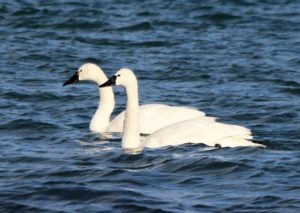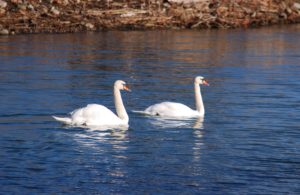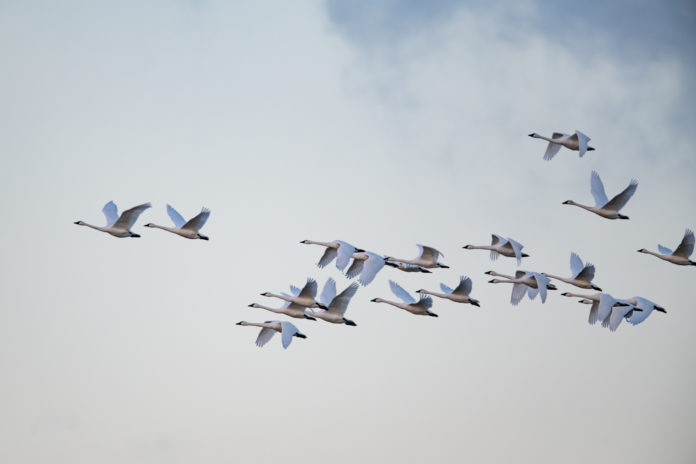By Larry Cornelis – President, Sydenham Field Naturalists
In Ontario we have three species of swans.
It was almost a ‘swan song’ for two of them, the trumpeter swan and tundra swan, both native species to Ontario.
They were actually extirpated (gone) from Ontario but have made a recent comeback.
The third species is the mute swan, an introduction from Europe.
People love to see swans and that’s easy to do in our area.
I saw many today (March 12th).
Trumpeter Swan
Thanks to reintroduction and conservation efforts in Ontario in 1982, trumpeter swan populations are now considered self-sustaining.
Trumpeter swan is our largest species with an 80” wing span and weighing up to 23 lbs.
Our Ontario populations are basically nonmigratory other than moving to areas of open water during the winter.
Wild populations in the west do migrate.
Trumpeters can be difficult to distinguish from tundra swans.
They are larger but without perspective, that can be difficult to tell.
Their all-black bill does not have a yellow spot/area in front of the eye, which the tundra has.
They are usually found in pairs or family groups.
Trumpeters are still uncommon and rare to see in our area.
I’ve seen a few in the St. Clair winter during the late fall and winter.
Tundra Swan

This is the migrating swan that we see in early March migrating through our area (Dover to Wallaceburg) and found by the thousands in corn stubble and winter wheat fields and in open waters like Rondeau Bay and Mitchell’s Bay if the ice is out.
Another great local spot to see tundra swans is near Pinery Provincial Park along Greenway Road where this past week (March 10th) there was an estimated 18,000 birds.
They fly in a V-shaped formation like geese during migration.
Their loud calls can be heard from hundreds of metres away, often before or after they can be seen.
These large white birds are very beautiful against a deep blue sky.
Tundra swans are circumpolar, nesting in arctic and subarctic areas around the world.
In Ontario they nest along the Hudson Bay coastal areas.
Basically, they nest in the tundra, hence the common name.
This is our smallest swan species although with a 66” wingspan and weighing 14 lbs., it’s still a very large bird.
They are a true sign that spring is here.
I encourage you to go for a drive this week and see if you can find some.
Mute Swan

This is the species seen in our area year-round, including during breeding season.
Last year, there were two nesting pairs at the Peers Wetland just outside of Wallaceburg.
They are an introduction from Europe and are therefore non-migratory.
A drive along the St. Clair River will usually provide an opportunity to see these large beautiful swans with long arching necks.
They are considered a threat to other waterfowl species as the can aggressively attack and displace our native species.
Their populations have been growing exponentially thanks to our recently milder winters but a severe cold winter could
really set them back.
The first nest was found in Ontario in 1958.
They can easily be distinguished from our native swans by their bright orange bills.
They are a little smaller than trumpeter swans with a 75” wingspan and weighing 20 lbs.
For more details, visit: http://www.sydenhamfieldnaturalists.ca/
















